Ebook social DRM & watermarking

Does social DRM or social watermarking stop ebook piracy & what are secure alternatives?
So-called “social DRM” has grown in popularity over the past few years, but is it any good? Most watermarking can be easily removed – so what is a secure alternative?
 What is social DRM or social watermarking?
What is social DRM or social watermarking?

Social watermarking and social DRM refer to the same practice: a form of digital watermarking for ebooks designed to identify the source of unauthorized distribution. It embeds the purchaser’s name and email address in several places in the document so that, theoretically, the publisher could trace any unauthorized sharing back to them.
Publishers usually choose watermarks for ebook distribution rather than a traditional DRM solution because it allows the user to view the ebook across more formats and devices. This blog will cover everything you need to know about social DRM as a security mechanism, including:
- What does social watermarking actually achieve
- Is digital watermarking for ebooks effective anti-piracy?
- Alternatives to social DRM & watermarking
- Locklizard – the best social DRM watermarking alternative
- How to watermark an ebook with Safeguard
- The bottom line
 What does social watermarking actually achieve?
What does social watermarking actually achieve?

Social watermarking gives publishers a semblance of protection while allowing users to read their ebooks on any device. It embeds the buyers’ personal details into the ebook itself, both visibly and invisibly, identifying the original owner of a copy.
However, it’s not hard to see the flaws in this implementation. Despite its labeling as “DRM”, social watermarking is anything but. It does not restrict what the user can do with the ebook – they are free to modify it as they wish.
 How to remove invisible watermarks from ebooks with Calibre
How to remove invisible watermarks from ebooks with Calibre
As a result, it’s not too difficult to just edit out the visible watermarks. That’s exactly what a team of researchers did with BooXtream who use social DRM watermarking. Free software like Calibre or Sigil let you do a quick find and replace in ebook xHTML files to delete all identifiers. According to the researchers, invisible watermarks can also be negated – through a combination of editing file names, the ebook’s CSS, and image metadata.
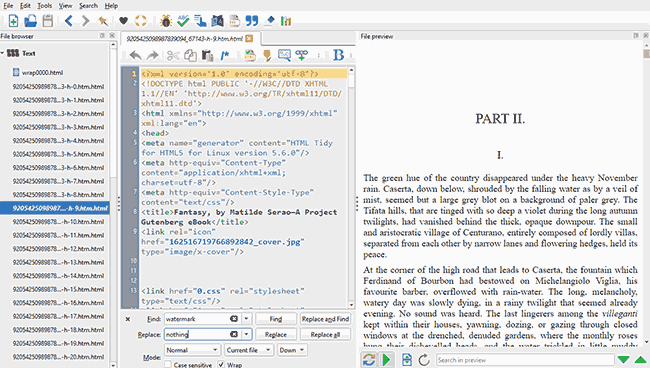
Ultimately, a social DRM’s effectiveness hinges on whether its methods of hiding digital identifiers remain undiscovered. It’s security through obscurity – and that obscurity is rapidly falling apart.
 Is digital watermarking for ebooks effective anti-piracy?
Is digital watermarking for ebooks effective anti-piracy?

A digital watermark is only as effective as the ebook’s copy protection. An ebook with a watermark but no protection against editing or copying will end up on file-sharing sites with its protection stripped. Combining a watermark with the right DRM solution can be very potent, however. A non-removable, dynamic watermark is a strong deterrent should primary anti-sharing mechanisms fail.
 Do anti-AI watermarks work?
Do anti-AI watermarks work?
Another major issue for authors and artists in recent times is the use of their art by artificial intelligence models. Some services offer “anti-AI” watermarks as a result. These are typically invisible to the human eye but readable by AI scraping tools. They usually mark your legitimate work as being generated by AI in the hopes that AI companies only want to train on human content.
At the time of writing, these watermarks do not really do anything. There is no strong legal protection for artists against such use, and as a result, AI companies can ignore the watermark and use the image anyway. There’s no evidence that AI companies are avoiding scraping AI-generated content, and marking your content as AI-generated could have negative consequences for you down the line.
Other tools are specifically for images and apply a special type of noise that they claim confuses AI models during the training process. However, though it is claimed that this noise is barely perceptible to the human eye, we found it to beobvious and distracting. Currently, the best way to prevent AI scraping is to stop scrapers from being able to open your content at all.
 Alternatives to social DRM & watermarking
Alternatives to social DRM & watermarking

There are several ways ebook publishers can protect their books beyond social watermarking, but not all of them are effective. The type of protection on offer is heavily dependent on the file format of your ebook and the DRM you choose to use.
Kindle DRM
Ebooks published in AZW or KFX format usually make use of Amazon’s proprietary DRM for Kindle books. The DRM is quite a bit more restrictive than social DRM – only allowing readers to consume the ebooks on a Kindle device or a computer, tablet, or phone running Kindle software.
Unfortunately, it’s no more effective than social watermarking despite being more restrictive. Kindle DRM has been a large target for pirates since its release in 2007, and as a result, there are various free and user-friendly tools available to strip its DRM, such as Epubor and Calibre plugin DeDRM.

Removing the DRM from a Kindle book with Epubor
Adobe ADEPT DRM
Adobe’s ADEPT DRM, used for its Digital Editions software, is among the most popular in the market. It’s used to protect EPUB and PDF file formats and is the basis for several other DRMs, including those from Barnes & Noble and Kobo.
Unfortunately, it was cracked just two years after its 2007 release and has been easy to remove ever since. Though a fairly well-designed cryptographic system, Adobe ADEPT is not very effective at DRM due to its relative lack of obfuscation. The transparency surrounding its RSA key encryption and storage allowed researchers to quickly crack it and it can now be removed using Epubor and Calibre with minimal effort. This applies to both its EPUB and PDF protection.

Removing the DRM from an Adobe ADEPT protected book with Epubor
Adobe Acrobat Protection
Adobe Acrobat is not really intended to be a DRM tool, but it has protection, nonetheless. This has led to many trying to use the software to protect their ebook from piracy. Unfortunately, the security is both completely useless and impossible to use at scale.
This is because Acrobat relies on password protection. Once a user knows the password (which they are given to view their ebook) they can pass it on to whomever they like. They can also remove the password instantly, along with any editing or printing restrictions applied to the ebook. Finally, manually creating passwords for every customer who purchases your ebook just isn’t sustainable.
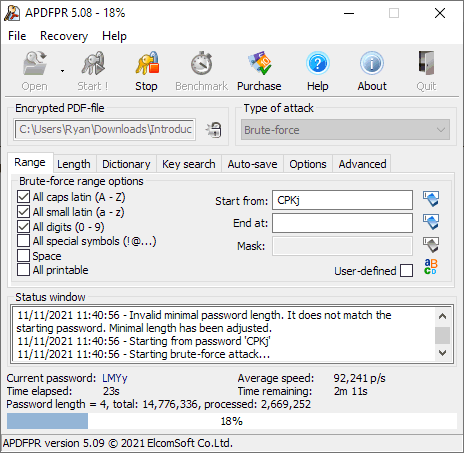
Removing the password from a PDF protected book with Elcomsoft
Secure one-time download links
One-time download links are another protection mechanism that doesn’t involve DRM. You automatically generate a download link for the ebook and after one use the link expires. It only takes a few seconds to realize the flaws in this method, though – once the user has their ebook, they can just re-upload it to share with other people. On top of this, it’s not particularly convenient for consumers if they have to email you whenever they want a new link.

WordPress one-time links plugin
 Locklizard – the best social DRM watermarking alternative
Locklizard – the best social DRM watermarking alternative
As you may have gathered by now, all of the major ebook DRM systems or solutions are completely ineffective at preventing ebook piracy. It doesn’t matter whether you distribute in epub, mobi, azw or PDF; Amazon, Adobe, and co. can’t protect your ebooks from piracy.
Locklizard provides a cost-effective alternative to these solutions – and the best part is that it actually works. Through a combination of strong cryptography, a secure licensing system, and a secure viewer application, Safeguard PDF Security can both add irremovable dynamic watermarks to your ebooks and act as effective copy protection.
Safeguard’s default DRM security:
- Stops users editing, copying, printing, screenshotting, and pasting content
- Locks ebooks to specific devices so they cannot be shared with others
- No passwords for users to enter, manage, or remove
- The ability to revoke ebooks at any time, regardless of where they reside
- Provides a choice between offline or flexible online and offline use

 How does Locklizard protect ebooks from piracy?
How does Locklizard protect ebooks from piracy?

Instead of using passwords, Locklizard’s PDF DRM solution stores decryption keys that are securely relayed from its licensing system on the customer’s PC. These are saved in an encrypted keystore which is locked to each device, meaning pirates can’t share their ebook copy with others.
Once encrypted, PDF files are saved in a proprietary.PDC format that users can only open with the Safeguard Viewer application. Unlike Acrobat, Safeguard Viewer is security-hardened and leaves users with no easy route to bypass its anti-editing, copying, printing, and screenshotting controls. As a result, they can’t remove their identifying watermark in a PDF editor even if they wanted to.
Despite this unmatched protection, the process to protect an ebook with Safeguard is easy:
- You encrypt a PDF ebook on your local PC and add any DRM controls and watermarks you want to enforce.
- Your protected PDF ebook is saved to your disk, and a document record is created on the Admin System.
- You create a user account for each user you want to view your protected ebook.
- An email is automatically sent to the user with a link to the Viewer and their license file.
- Once the Viewer is installed and the license file activated (clicked-on) it is registered to that device and cannot be registered elsewhere (unless otherwise specified).
- You control from the Admin System, which protects the ebooks each user can access.
- You distribute your DRM protected ebooks just like any other file (email, web site, etc.).
- A protected ebook can only be opened by someone who has been authorized to view it. Depending on your DRM controls, they also cannot be printed, edited, copied, or screen grabbed. Sharing is always prevented since the recipient must be authorized to view the ebook – if they are sent a protected ebook and a user has not been authorized to view it, then it will not open. You can also automatically expire ebooks based on their age, number of opens or prints, and instantly revoke access.
If you’re selling ebooks at scale, the Locklizard e-commerce API makes it even simpler. Publishers can use it to automatically add customers to the admin portal and send their license file once the purchase is completed.
 How to watermark an ebook with Safeguard
How to watermark an ebook with Safeguard
Applying a dynamic watermark with Locklizard Safeguard PDF writer is simple despite the advanced functionality on offer. Here’s the full process:
- Right-click your PDF ebook in Windows File Explorer and select the option “Make Secure PDF”.
%22%20transform%3D%22translate(1.2%201.2)%20scale(2.41016)%22%20fill%3D%22%23fff%22%20fill-opacity%3D%22.5%22%3E%3Cellipse%20rx%3D%221%22%20ry%3D%221%22%20transform%3D%22matrix(-.5809%2027.73216%20-106.81608%20-2.23748%20197.3%200)%22%2F%3E%3Cellipse%20rx%3D%2246%22%20ry%3D%2230%22%2F%3E%3Cellipse%20rx%3D%221%22%20ry%3D%221%22%20transform%3D%22matrix(84.31433%2010.80091%20-3.55798%2027.77434%20176%200)%22%2F%3E%3C%2Fg%3E%3C%2Fsvg%3E)
Creating a protected PDF ebook
Add text watermark to your ebook
In the “View Watermarks” tab check the “Add Text Watermark” box.
%22%20transform%3D%22translate(1.3%201.3)%20scale(2.5625)%22%20fill-opacity%3D%22.5%22%3E%3Cpath%20fill%3D%22%23cfcfcf%22%20d%3D%22M13.8%20120l-67-64.6L62.3-64l67%2064.6z%22%2F%3E%3Cellipse%20fill%3D%22%23d2d2d2%22%20cx%3D%22154%22%20cy%3D%22243%22%20rx%3D%22172%22%20ry%3D%2227%22%2F%3E%3Cellipse%20fill%3D%22%23fff%22%20rx%3D%221%22%20ry%3D%221%22%20transform%3D%22rotate(-33.9%20274.9%20-110.1)%20scale(128.97757%2078.79056)%22%2F%3E%3C%2Fg%3E%3C%2Fsvg%3E)
Adding a text watermark to an ebook
After typing your watermark text, you can add dynamic information by selecting the editing icon and choosing your dynamic variables. For example, %UserName% and %Email% to identify the user.
The “Position” and “Opacity” sliders allow you to adjust where the watermark sits on the page and its transparency, while the font icon, “Aa”, enables you to adjust font color, size, and formatting options.
Here’s an example of what a dynamic watermark looks like when an ebook is viewed in Safeguard’s Viewer:
%27%20fill-opacity%3D%27.5%27%3E%3Cellipse%20fill%3D%22%23349ae9%22%20fill-opacity%3D%22.5%22%20rx%3D%221%22%20ry%3D%221%22%20transform%3D%22matrix(-.01697%20-67.35451%20619.92174%20-.15617%20334.3%201.3)%22%2F%3E%3Cellipse%20fill%3D%22%23fff%22%20fill-opacity%3D%22.5%22%20rx%3D%221%22%20ry%3D%221%22%20transform%3D%22matrix(174.2054%20-88.55044%20158.31185%20311.44711%20542.4%20423.5)%22%2F%3E%3Cellipse%20fill%3D%22%23fff%22%20fill-opacity%3D%22.5%22%20rx%3D%221%22%20ry%3D%221%22%20transform%3D%22rotate(-76.5%20247.7%20130.4)%20scale(216.83371%2094.12151)%22%2F%3E%3C%2Fg%3E%3C%2Fsvg%3E)
Text watermark displayed in Safeguard Secure PDF Viewer
Add a watermark image to your ebook
In the “View Watermarks” Image Watermark tab, check the ‘Add Image watermark’ box.
%27%20fill-opacity%3D%27.5%27%3E%3Cellipse%20fill%3D%22%23d1d1d1%22%20fill-opacity%3D%22.5%22%20rx%3D%221%22%20ry%3D%221%22%20transform%3D%22rotate(-51.1%20127.4%20-55.6)%20scale(181.90423%20162.60407)%22%2F%3E%3Cellipse%20fill%3D%22%23cfcfcf%22%20fill-opacity%3D%22.5%22%20rx%3D%221%22%20ry%3D%221%22%20transform%3D%22matrix(476.38587%20-122.96545%2018.14693%2070.30384%20353.3%20614.1)%22%2F%3E%3Cpath%20fill%3D%22%23fff%22%20fill-opacity%3D%22.5%22%20d%3D%22M64.1%20618l-94-327.6L502.3%20138l94%20327.6z%22%2F%3E%3C%2Fg%3E%3C%2Fsvg%3E)
Adding an image watermark
Browse for the image watermark you want to add. A large background watermark is usually a good idea, as it will be visible anywhere on the page.
Modifying the opacity slider allows you to do this without being too obtrusive, like so:
%22%20transform%3D%22translate(1.2%201.2)%20scale(2.4375)%22%20fill-opacity%3D%22.5%22%3E%3Cellipse%20fill%3D%22%233fa4e5%22%20rx%3D%221%22%20ry%3D%221%22%20transform%3D%22matrix(-222.3766%204.65813%20-.59903%20-28.59718%20176%20.2)%22%2F%3E%3Cellipse%20fill%3D%22%23fff%22%20rx%3D%221%22%20ry%3D%221%22%20transform%3D%22matrix(.04598%2073.54704%20-120.52606%20.07536%20238%20138.7)%22%2F%3E%3Cellipse%20fill%3D%22%23fff%22%20cx%3D%22210%22%20cy%3D%22137%22%20rx%3D%2293%22%20ry%3D%2253%22%2F%3E%3C%2Fg%3E%3C%2Fsvg%3E)
Confidential image watermark displayed in Safeguard Secure PDF Viewer
- If you have allowed printing of your ebook then you will probably want to add print watermarks as well. These can be added from the Print watermarks tab. Ebook watermarking options are flexible so you can add different view and print watermarks as you see fit.
- Save your watermarks and other security controls by pressing the “Publish” at the bottom of the PDF Writer window. Make sure you have any other security controls you want to apply selected before you do so, as outlined earlier in this article. Remember, by default, users cannot share, edit, copy or paste content, print, or take screenshots using screen capture tools.
Once you publish your ebook, by default users will not be able to share, edit, copy or paste content, print, or take screenshots using screen capture tools. As a result, they can’t remove your watermark or distribute a version with the protection stripped.
 The bottom line
The bottom line

Ebook social watermarking or DRM social watermarking, is not an effective way to prevent piracy. Though unprotected watermarks may be enough to scare away non-technical users, a determined pirate will just remove them and move on.
With alternatives like Adobe and Kindle DRM no help either, ebook publishers are better off distributing their ebook as a PDF using Safeguard Security. With irremovable watermarks, strong anti-sharing and editing controls, and no per-sale fee, Locklizard’s PDF DRM solution is the best route to protect publisher revenue and author royalties when selling ebooks online.
To stop ebook piracy and protect your ebooks from sharing, take a free 15 day trial of our PDF copy protection software.
 FAQs
FAQs

Is PDF a good ebook format?
Yes. Like any format, PDF has its advantages and disadvantages when it comes to ebook use. Its main limitation is its inability to adapt its contents to the screen size of the device viewing it. An ebook that looks different on each device isn’t necessarily a good thing, however, and authors who publish in PDF get the added benefits of almost universal device compatibility and strong anti-piracy solutions, while being able to quickly export as PDF from numerous writing applications.
Is DRM the best protection for ebooks?
Though solutions like digital watermarking can be more convenient for the end-user, digital rights management solutions remain the most effective way to prevent piracy. They’re able to achieve a similar deterrent to social watermarking through irremovable, dynamic watermarks while additionally preventing copying, screenshotting, and editing.
Do I need DRM on my ebook?
It depends on what you want to get out of ebook publishing. If your intention is to make a living selling ebooks, then DRM is always a good idea – it will protect your revenue against piracy. If profit is secondary to you or you only want to reach a small audience, DRM is less vital.
Where can I sell my Locklizard protected ebook?
Once your ebook is protected with Safeguard, you can distribute it anywhere you’d usually sell PDFs. This could be your own website, your publisher’s website, a third-party marketplace, or book retailer.

 What is social DRM or social watermarking?
What is social DRM or social watermarking? What does social watermarking actually achieve?
What does social watermarking actually achieve? How to remove invisible watermarks from ebooks with Calibre
How to remove invisible watermarks from ebooks with Calibre Is digital watermarking for ebooks effective anti-piracy?
Is digital watermarking for ebooks effective anti-piracy? Do anti-AI watermarks work?
Do anti-AI watermarks work? Alternatives to social DRM & watermarking
Alternatives to social DRM & watermarking Locklizard – the best social DRM watermarking alternative
Locklizard – the best social DRM watermarking alternative How does Locklizard protect ebooks from piracy?
How does Locklizard protect ebooks from piracy? How to watermark an ebook with Safeguard
How to watermark an ebook with Safeguard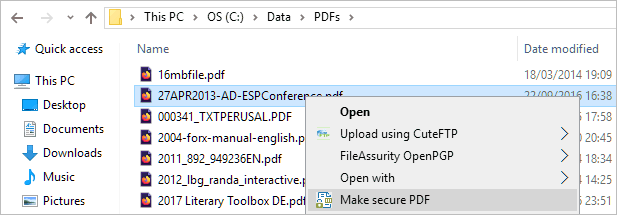
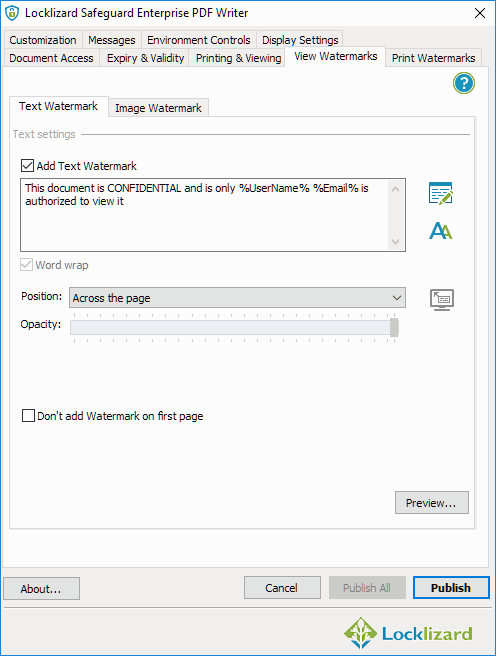
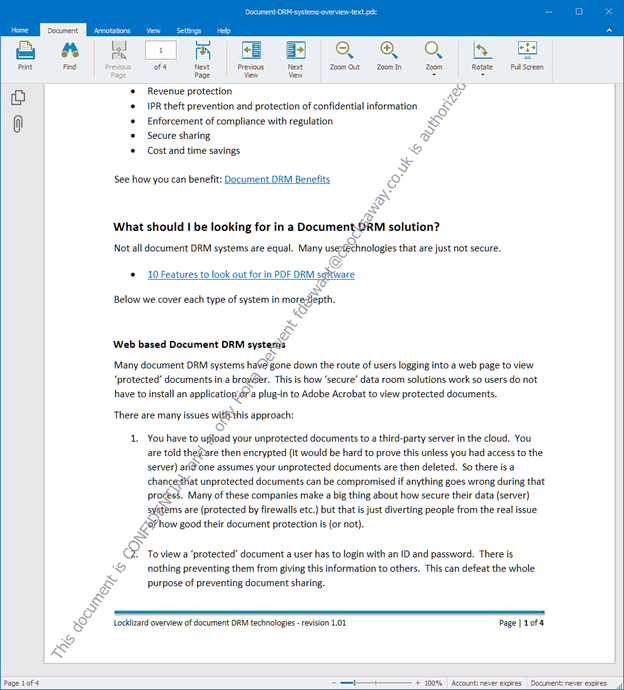
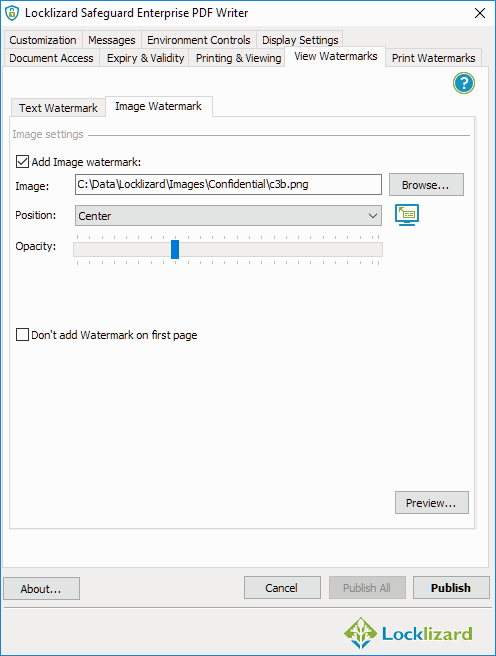
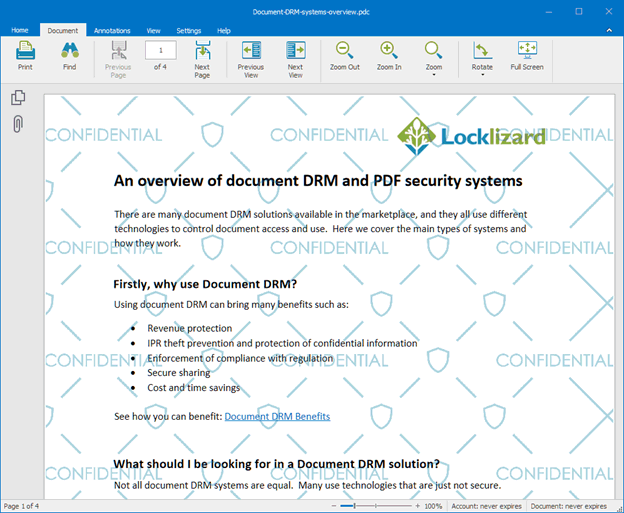
 The bottom line
The bottom line FAQs
FAQs
